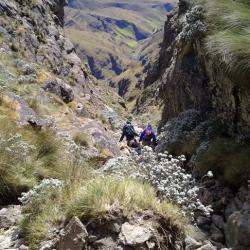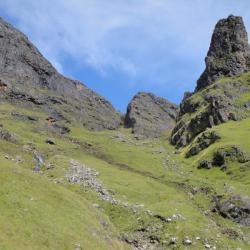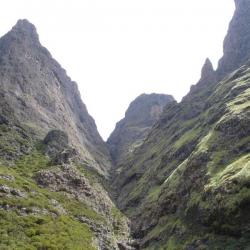An index of passes in the Northern Drakensberg of KwaZulu-Natal.
|
Pass |
Height |
Co-ordinate (WGS84) |
Difficulty rating 1-10 |
Key aspects |
Used by locals |
GPS data |
Photo
|
| Chain Ladders | 3010m | S28 44.863 E28 52.827 | 1 |
|
yes | ||
| Beacon Buttress Gully | 3109m | S28 44.723 E28 53.439 | 4 |
|
unlikely |

|
|
| Sentinel Gully |
|
unlikely | |||||
| Gudu Pass | 2205m | S28 41.147 E28 53.963 |
|
? | |||
| Inner Tower Gully (Western / RNNP) | 3060m | S28 45.974 E28 55.810 |
|
unlikely | |||
| Inner Tower Gully (Eastern / Busingatha) | 3060m | S28 45.974 E28 55.810 |
|
unlikely | |
||
| Ifidi Pass | 3040m | S28 47.257 E28 56.361 | 10 |
|
minor | ||
| Icidi Pass | 3095m | S28 48.463 E28 55.965 | 10 |
|
minor | ||
| Mbundini Pass | 3150m | S28 50.695 E28 56.765 | 7 |
|
unlikely | ||
| Madonna Pass | 2970m | S28 51.348 E28 56.660 | 7 |
|
unlikely | ||
| Fangs Pass | 3037m | S28 51.687 E28 56.407 | 7 |
|
unlikely | ||
| Rwanqa North Pass (Tata Ma Chance Pass) | 3100m |
S28 52.239 E28 57.607 |
|
unlikely | |||
| Rwanqa Pass | 3088m | S28 52.583 E28 57.430 | 7 |
|
minor | ||
| Black and Tan Wall Pass North | 3170m |
S28 52.223 E28 57.827 |
8 |
|
unlikely | ||
| Black and Tan Wall Pass South | 3150m |
S28 53.366 E28 54.194 |
|
unlikely | |||
| Pins Pass | 3185m | S28 53.476 E28 58.473 | 8 |
|
unlikely | ||
| Manxome Pass |
3169m | S28 53.475 E28 58.859 | 9 |
|
unlikely | ||
| Hanging Valleys Pass | 3045m |
S28 53.963 E28 58.831 |
|
unlikely | |||
| Mnweni Buttress Pass |
2975m |
S28 54.044 E28 59.963 |
|
unlikely | |||
| Mnweni Pass | 2888m | S28 53.659 E29 00.721 | 6 |
|
major | ||
| Ledges Pass |
2920m / 2900m |
S28 53.023 E29 00.747 / S28 53.018 E29 00.733 |
8 |
|
unlikely | ||
| Mponjwane Pass |
3020m |
S28 53.483 E29 01.904 |
|
unlikely | |||
| Mnweni Needles Pass | 2590m |
S28 52.497 E29 02.217 |
6 |
|
unlikely | ||
| Rockeries Pass | 2901m | S28 53.833 E29 01.696 | 5 |
|
major |

|
|
| Nguza Pass | 2923m | S28 55.113 E29 03.502 | 7 |
|
unlikely | |
|
| 3022m | S28 55.347 E29 04.312 | 5 |
|
unlikely | |||
| Ntonjelana Pass North | 3060m | S28 55.770 E29 04.473 | 5 |
|
unlikely | |
|
| Ntonjelana Pass | 2883m | S28 56.334 E29 05.613 | 4 |
|
major |

|
|
| Christmas Pass | 2894m | S28 56.893 E29 06.062 | 7 |
|
unlikely | ||
| Twins Pass | 2835m |
S28 57.047 E29 06.781 |
5 |
|
unlikely | ||
| Mlambonja Pass (Bell Traverse) | 2965m | S28 57.216 E29 06.716 | 5 |
|
yes | ||
| Mlambonja Pass | 2965m | S28 57.216 E29 06.716 | 6 |
|
yes | ||
| Mlambonja South Pass | 2960m |
S28 57.294 E29 06.809 |
|
unlikely | |||
| Mlambonja Buttress North Pass | 2975m |
S28 57.750 E29 07.333 |
|
unlikely | |||
| Mlambonja Buttress South Pass | 2970m |
S28 58.075 E29 07.530 |
8 |
|
unlikely | ||
| Xeni Pass (North Fork) | 3005m | S28 58.221 E29 07.373 | 8 |
|
unlikely |

|
|
| Xeni Pass (South Fork) | 3052m | S28 58.390 E29 07.317 | 7 |
|
unlikely | |
|
| Elephant Gully | 3110m | S28 58.803 E29 07.739 | 2 |
|
yes | ||
| Cockade Pass | 2964m | S28 59.052 E29 08.237 | 6 |
|
minor | ||
| Cockade Pass - Southern Variation | 2985m | S28 59.028 E29 08.302 | 6 |
|
unlikely | ||
| False Tseketseke Pass | 2950m |
S28 59.358 E29 08.920 |
|
unlikely | |||
| Tseketseke Pass | 3001m | S28 59.445 E29 09.097 | 6 |
|
minor | ||
| Tseketseke Pass - Southern Variation | 3160m | S28 59.818 E29 09.229 | 6 |
|
unlikely | ||
| Organ Pipes Pass (Camel) | 2960m | S29 00.632 E29 10.948 | 4 |
|
major | ||
| Organ Pipes Pass (Thuthumi Ridge) | 2960m | S29 00.632 E29 10.948 | 4 |
|
major | ||
| Thuthumi Pass | 3074m | S29 00.815 E29 11.217 | 5 |
|
major | ||
| 2952m | S29 00.847 E29 11.957 | 5 |
|
major | |||
| Mike's Pass | 1846m | S28 58.115 E29 14.080 |
|
yes | |||
| Windsor Castle Pass | 3034m | S29 01.278 E29 12.478 |
|
unlikely | |
||
| Tlanyaku Pass | 2760m | S29 02.922 E29 13.507 | 5 |
|
major | ||
| Didima Pass | 2960m |
S29 03.749 E29 13.593 |
|
unlikely |
Notes
1. By Drakensberg standards the majority of passes are those which provide access to the escarpment, and this is naturally where much of the interest by hikers lies. Some trails that provide access to the Little Berg plateau have been designated the status of "pass" in the names that were given to them. This list simply honours that historical designation, and no attempt it made in determining whether other trails that provide access to the Little Berg should be given the same designation. Some passes provide passage over a range, but not to the escarpment. These are included in this list on a case-by-case basis that is mainly driven available documentation provided by those who explore these options. Finally, some unusual routes, such as ones that link up the summits of two different passes via a traverse are also included here on a case-by-case basis.
2. Some passes can be considered classic in the sense that they offer a good, recommended route that has a well-worn trail. Other passes may have less of a trail, or no trail at all, but may still be good options for reasonably fit and competent hikers. Some routes are very adventurous, often being strenuous, crossing difficult terrain, and with challenging route-finding. Certain routes may even be described as "technical". This list, in seeking to be comprehensive, lists all of the above. It could be argued that some routes listed here are actually mountaineering routes and should not be referred to as a "pass". Several routes listed here could land a party up in serious trouble if they are ill-prepared or if they have wrongly assessed their own competency. The reader is asked to use the information presented here with caution and sober assessment.
3. Passes may have more than one route leading to the same summit point. Others have routes that converge well below the summit. On the other hand there are passes that are considered distinct from each other yet share common approaches, while others are described as variations of a main route. While attempting to draw attention to what options are available to hikers, this list currently does not follow strict definitions in how these distinctions are made.
4. The names provided have a variety of origins and should by no means be considered final or official. While many names used here are well established and documented in classic Drakensberg literature and maps, there are a significant amount that have arisen in more recent times. Many have been put forward and utilised by hikers who are active on Vertical Endeavour's forum (or who at least follow the forum). There is currently no system for documenting these origins. There is also no framework or set of guidelines whereby such names can be proposed, researched, ratified or even revised. There may be other names in use that could be more appropriate - even among hikers different names may be used. Even in the absence of alternate names, the ones put forward may not always be the most appropriate ones.
5. Heights are drawn from maps wherever possible, and in some cases from literature. In the absence of these, the heights are drawn from hand-held GPS readings, which may not be accurate. Currently there is no system for indicating where the figure comes from. Figures may be adjusted from time to time.
6. These co-ordinates are recorded using hand-held GPS devices and thus may be subject to a degree of inaccuracy. Likewise, using this data across different devices will also result in some variance.
7. The difficulty grading system is developed and maintained by Stijn Laenen, Jonathan Newman and Tony Marshall on a voluntary basis. Effort is made to maintain accuracy and eliminate bias but readers are reminded that any sort of grading system is subject to interpretation and opinion. One person's experience on a pass will differ from another due to a variety of reasons. The ratings are a comparison of Berg passes relative to each other - always bear in mind that all Berg passes should be considered challenging hikes in a mountainous environment. A good level of fitness, resilliance and competency is required for any Berg pass. While aimed at being a useful guide, remember that the authors cannot be held responsible for the way this information is used, nor for any adverse outcomes resulting from decisions which were made using this information.
8. Keywords are used to convey important ascepts about each pass in a succinct manner. They help paint a picture of what a pass may be like with the limitation that they may not always convey the entire picture. This feature is in a beta phase and is subject to frequent updates and corrections.
9. "Locals" here refers to other people who make use of these passes apart from hikers. They may be from South Africa or Lesotho and can include smugglers, rustlers, herdsmen, traders and migrant workers. The knowledge of which passes are used by them, and to what extent, helps create a realistic picture for hikers to know what to expect when exploring these mountains. This is particularly relevant for helping hikers make informed decisions to reduce their risk to crime. For example it is generally a good precaution to try not overnight directly on busy trails as much as possible. However, just because a pass is used heavily by locals does not necessarily mean that incidents are taking place there. The security-related discussions on our forum keep track of the "where", "what" and "why" of these incidents. Vertical Endeavour seeks to portray an accurate and honest picture of what is going on in the Berg - not to frighten people away but rather to help them make good decisions to reduce the risk of problems.
10. This page is always being updated, edited and improved as more or better information becomes available. Those who have contributed to the maintenance of this information include Chris Sommer, Merv Gavin, Andrew Porter and Tony Marshall.


